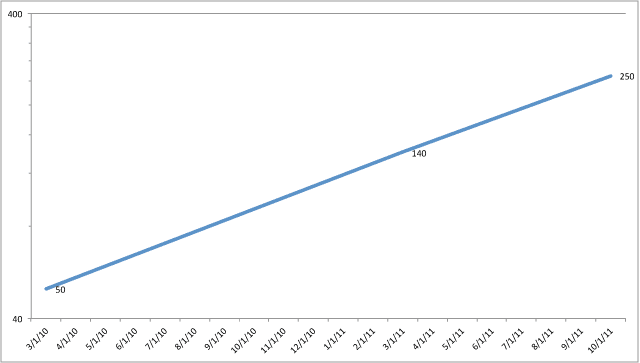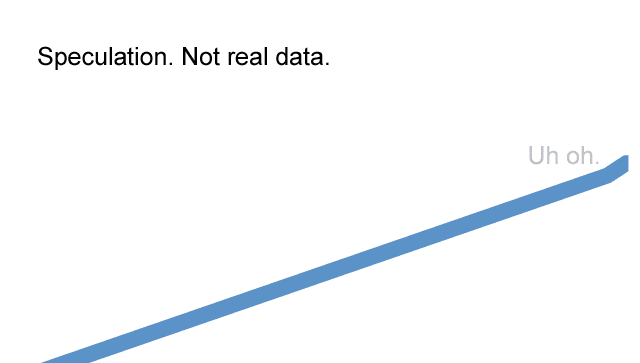Last week at the Web 2.0 Summit in San Francisco, Twitter CEO Dick Costolo talked about recent growth in the service and how iOS5 had caused a sudden 3x jump in signups. He also said daily Tweet volume had reached 250 million. There are many, many estimates of the volume of Tweets sent, but I know of only three which are verifiable as directly from Twitter:
- 50M tweets/day in March, 2010 according to a Twitter blog post.
- 140M tweets/day in March, 2011 according to that same Twitter blog post.
- 250M tweets/day in late October, 2011 according to Dick Costolo.
Graphing these on a log scale shows the rate of growth in Tweet volume, roughly tripling in two years almost tripling in one year.

This graph is misleading though, as we have so few data points. It is very likely that, like signups for the service, the rate of growth in tweet volume suddenly increased after iOS5 shipped. Lets assume the rate of growth also tripled for the few days after the iOS5 launch, and zoom in on the tail end of the graph. It is quite similar up until a sharp uptick at the end.

The reality is somewhere between those two graphs, but likely still steep enough to be terrifying to the engineers involved. iOS5 will absolutely have an impact on the daily volume of Tweets, it would be ludicrous to think otherwise. It probably isn't so abrupt a knee in the curve as shown here, but it has to be substantial. Tweet growth is on a new and steeper slope now. It used to triple in a bit over a year, now it will triple in way less than one year.
Why this matters
Even five months ago, the traffic to carry the Twitter Firehose was becoming a challenge to handle. At that time the average throughput was 35 Mbps, with spikes up to about 138 Mbps. Scaling those numbers to today would be 56 Mbps sustained with spikes to 223 Mbps, and about one year until the spikes exceed a gigabit.
The indications I've seen are that the feed from Twitter is still sent uncompressed. Compressing using gzip (or Snappy) would gain some breathing room, but not solve the underlying problem. The underlying problem is that the volume of data is increasing way, way faster than the capacity of the network and computing elements tasked with handling it. Compression can reduce the absolute number of bits being sent (at the cost of even more CPU), but not reduce the rate of growth.
Fundamentally, there is a limit to how fast a single HTTP stream can go. As described in the post earlier this year, we've scaled network and CPU capacity by going horizontal and spreading load across more elements. Use of a single very fast TCP flow restricts the handling to a single network link and single CPU in a number of places. The network capacity has some headroom still, particularly by throwing money at it in the form of 10G Ethernet links. The capacity of a single CPU core to process the TCP stream is the more serious bottleneck. At some point relatively soon it will be more cost effective to split the Twitter firehose across multiple TCP streams, for easier scaling. The Tweet ID (or a new sequence number) could put tweets back into an absolute order when needed.

Update: My math was off. Even before the iOS5 announcement, the rate of growth was nearly tripling in one year. Corrected post.